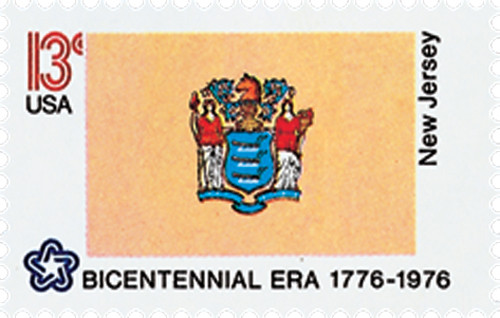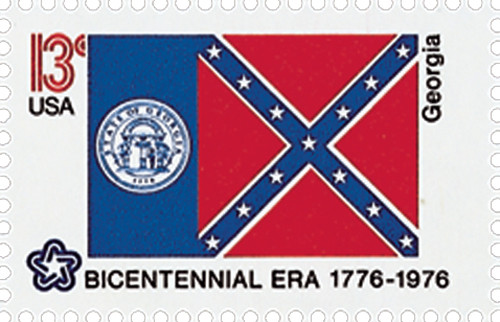
# 1637 - 1976 13c State Flags: Connecticut
U.S. 1637
1976 Connecticut State Flag
State Flags
American Bicentennial Series
• First time a sheet 50 had all different stamp designs
• Part of the American Bicentennial Series
Stamp Category: Commemorative
Series: American Bicentennial Series
Value: 13¢ First-class postage rate
First Day of Issue: February 23, 1976
First Day City(s): Washington, DC
Quantity Issued: 8,720,100 (panes of 50)
Printed by: Bureau of Engraving and Printing
Printing Method: Photogravure
Format: Sheet of 50
Perforations: 11
Why the stamp was issued:
The United States Postal Service celebrated the American Bicentennial with a full pane of the Union’s fifty state flags.
About the stamp design:
The state flag of Connecticut is royal blue field with a white baroque shield in the middle. On the face of the shield are three grapevines each bearing three purple bunches of grapes. A banner is located below the shield that reads “Qui Transtulit Sustinet” which is Latin for “He who transplanted sustains.”
About the printing process:
Printed by the Bureau of Engraving and Printing on their seven-color Andreotti gravure press (601) which was their work horse for multicolored stamps.
About the American Bicentennial Series:
In the 1970s, America celebrated its 200th anniversary with hundreds of national events commemorating the heroes and historic events that led to our nation’s independence from Great Britain. The U.S. Postal Service issued 113 commemorative stamps over a six-year period in honor of the U.S. bicentennial, beginning with the American Revolution Bicentennial Commission Emblem stamp (U.S. #1432). As a group, the Bicentennial Series chronicles one of our nation’s most important chapters, and remembers the events and patriots who made the U.S. a world model for liberty.
Several of the stamps honored colonial life – craftsmen and communication. Other stamps honored important battles including Lexington and Concord, Bunker Hill, and Saratoga. Significant events such as the Boston Tea Party, the meeting of the First Continental Congress, and the Declaration of Independence were featured as well. The stamps also honored many significant people such as George Washington, Sybil Ludington, Salem Poor, and the Marquis de Lafayette.
Many of the stamps feature classic artwork. For instance, the set of four souvenir sheets picture important events recreated by noted artists such as John Trumbull. The Bicentennial Series also includes an important US postal first – the first 50-stamp se-tenant – featuring all 50 state flags. The format proved to be popular with collectors, and has been repeated many times since.
The American Bicentennial Series is packed with important US history – it tells the story of our nation’s fight for independence through stamps.
History the stamp represents:
On January 9, 1788, Connecticut ratified the U.S. Constitution, making it the fifth state to join the young United States.
English colonists from Massachusetts founded Connecticut’s first permanent European settlement, Windsor, in 1633. Most of these settlers left Massachusetts seeking political and religious freedom. Other settlements quickly followed, including Hartford, New London, Saybrook, and Wethersfield. In 1636, Hartford, Wethersfield, and Windsor united to form the Connecticut Colony, also known as the River Colony.
As the number of Connecticut colonists grew, the native Pequot Indian tribe grew hostile, fearing that settlers would challenge their control of the region. After several Indian attacks, Captain John Mason led a small army aided by Mohegan and Narragansett warriors against the Pequot in 1637. Mason quickly defeated the Pequot.
The colony of New Haven was founded as a Puritan theocracy, or church-ruled state, in 1638. Five years later, Branford, Guillford, Milford, Stamford, and Southhold (located on Long Island) joined the New Haven colony. By 1660, many towns had joined the Connecticut Colony, including Fairfield, Farmington, Middletown, New London, Norwalk, Saybrook, and Stratford. In 1662, John Winthrop, Jr., of the Connecticut Colony, was granted a charter from the King of England. This charter gave the colony control of a 73-mile-wide strip of land running from Narragansett Bay to the Pacific Ocean (at that time, the distance to the Pacific was unknown). This area included the New Haven Colony. Despite objections from the New Haven colonists, the two were united in 1665.
A century later, as America waged war on England, the majority of Connecticut colonists favored independence. And on June 14, 1776, a resolution was passed backing this action. On July 4, 1776, Connecticut adopted the Declaration of Independence. Two years later, Connecticut approved the Articles of Confederation – the forerunner of the United States Constitution.
At the Constitutional Convention of 1787, Connecticut’s delegates played an important role in bringing about the Great Compromise, sometimes called the Connecticut Compromise. Delegates from large states wanted congressional representation to be based on population, while smaller states wanted representation to be equal. The Connecticut Compromise provided for representation based on population in the House and equal representation in the Senate. This compromise allowed both large and small states to fully support a central government and earned Connecticut the nickname, “The Constitution State.” Connecticut ratified the United States Constitution on January 9, 1788, making it the fifth state to join the Union.
U.S. 1637
1976 Connecticut State Flag
State Flags
American Bicentennial Series
• First time a sheet 50 had all different stamp designs
• Part of the American Bicentennial Series
Stamp Category: Commemorative
Series: American Bicentennial Series
Value: 13¢ First-class postage rate
First Day of Issue: February 23, 1976
First Day City(s): Washington, DC
Quantity Issued: 8,720,100 (panes of 50)
Printed by: Bureau of Engraving and Printing
Printing Method: Photogravure
Format: Sheet of 50
Perforations: 11
Why the stamp was issued:
The United States Postal Service celebrated the American Bicentennial with a full pane of the Union’s fifty state flags.
About the stamp design:
The state flag of Connecticut is royal blue field with a white baroque shield in the middle. On the face of the shield are three grapevines each bearing three purple bunches of grapes. A banner is located below the shield that reads “Qui Transtulit Sustinet” which is Latin for “He who transplanted sustains.”
About the printing process:
Printed by the Bureau of Engraving and Printing on their seven-color Andreotti gravure press (601) which was their work horse for multicolored stamps.
About the American Bicentennial Series:
In the 1970s, America celebrated its 200th anniversary with hundreds of national events commemorating the heroes and historic events that led to our nation’s independence from Great Britain. The U.S. Postal Service issued 113 commemorative stamps over a six-year period in honor of the U.S. bicentennial, beginning with the American Revolution Bicentennial Commission Emblem stamp (U.S. #1432). As a group, the Bicentennial Series chronicles one of our nation’s most important chapters, and remembers the events and patriots who made the U.S. a world model for liberty.
Several of the stamps honored colonial life – craftsmen and communication. Other stamps honored important battles including Lexington and Concord, Bunker Hill, and Saratoga. Significant events such as the Boston Tea Party, the meeting of the First Continental Congress, and the Declaration of Independence were featured as well. The stamps also honored many significant people such as George Washington, Sybil Ludington, Salem Poor, and the Marquis de Lafayette.
Many of the stamps feature classic artwork. For instance, the set of four souvenir sheets picture important events recreated by noted artists such as John Trumbull. The Bicentennial Series also includes an important US postal first – the first 50-stamp se-tenant – featuring all 50 state flags. The format proved to be popular with collectors, and has been repeated many times since.
The American Bicentennial Series is packed with important US history – it tells the story of our nation’s fight for independence through stamps.
History the stamp represents:
On January 9, 1788, Connecticut ratified the U.S. Constitution, making it the fifth state to join the young United States.
English colonists from Massachusetts founded Connecticut’s first permanent European settlement, Windsor, in 1633. Most of these settlers left Massachusetts seeking political and religious freedom. Other settlements quickly followed, including Hartford, New London, Saybrook, and Wethersfield. In 1636, Hartford, Wethersfield, and Windsor united to form the Connecticut Colony, also known as the River Colony.
As the number of Connecticut colonists grew, the native Pequot Indian tribe grew hostile, fearing that settlers would challenge their control of the region. After several Indian attacks, Captain John Mason led a small army aided by Mohegan and Narragansett warriors against the Pequot in 1637. Mason quickly defeated the Pequot.
The colony of New Haven was founded as a Puritan theocracy, or church-ruled state, in 1638. Five years later, Branford, Guillford, Milford, Stamford, and Southhold (located on Long Island) joined the New Haven colony. By 1660, many towns had joined the Connecticut Colony, including Fairfield, Farmington, Middletown, New London, Norwalk, Saybrook, and Stratford. In 1662, John Winthrop, Jr., of the Connecticut Colony, was granted a charter from the King of England. This charter gave the colony control of a 73-mile-wide strip of land running from Narragansett Bay to the Pacific Ocean (at that time, the distance to the Pacific was unknown). This area included the New Haven Colony. Despite objections from the New Haven colonists, the two were united in 1665.
A century later, as America waged war on England, the majority of Connecticut colonists favored independence. And on June 14, 1776, a resolution was passed backing this action. On July 4, 1776, Connecticut adopted the Declaration of Independence. Two years later, Connecticut approved the Articles of Confederation – the forerunner of the United States Constitution.
At the Constitutional Convention of 1787, Connecticut’s delegates played an important role in bringing about the Great Compromise, sometimes called the Connecticut Compromise. Delegates from large states wanted congressional representation to be based on population, while smaller states wanted representation to be equal. The Connecticut Compromise provided for representation based on population in the House and equal representation in the Senate. This compromise allowed both large and small states to fully support a central government and earned Connecticut the nickname, “The Constitution State.” Connecticut ratified the United States Constitution on January 9, 1788, making it the fifth state to join the Union.


















